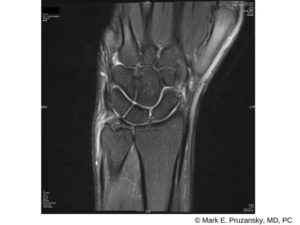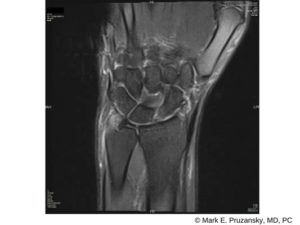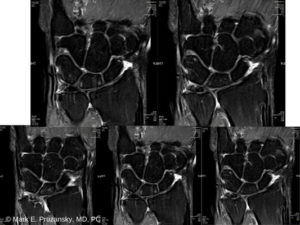Triangular Fibrocartilage Complex Tears

Peripheral foveal tear triangular fibrocartilage complex
What is a Triangular Fibrocartilage Complex Tear?
The Triangular Fibrocartilage Complex (TFCC) is a ligament and cartilage structure that connects the radius and ulna, and the wrist to the forearm. The TFCC plays an important role in stabilizing this side of the wrist. The TFCC is composed of ligaments that connects the forearm bones and a piece of cartilage that provides a smooth joint surface. With all of these structures together forming the TFCC, a Triangular Fibrocartilage Complex Tear represents an injury to one or several components.
Symptoms of Triangular Fibrocartilage Complex Tear
Pain and swelling are common in acute injuries. The pain is generally located on the little finger side of the wrist where the TFCC is located. Wrist motion may be difficult due to pain, and moving the wrist may elicit a “click” due to abnormal movement of wrist bones or the torn TFCC getting caught between the moving bones. In chronic injuries, pain may still be present with certain wrist movements and a feeling of weakness and/or instability may exist.

Dorsal peripheral triangular fibrocartilage complex tear from its foveal
Common Causes of Triangular Fibrocartilage Complex Tear
A fall onto a hyper-extended wrist is a common cause, such as during skiing, snowboarding, football, and basketball. Tennis can lead to this injury, with the backhand stroke often the culprit. TFCC tears also occur from age-related wear and tear.
Diagnosing Triangular Fibrocartilage Complex Tear

Volar tfcc tear from its attachment to the fovea of the ulnar head.
Speaking with you to understand how the injury happened and carefully examining all aspects of your wrist, forearm, and hand are essential. With so many small structures near each other, the physical exam is very important to accurately pinpoint the injury. An x-ray will rule out fractures and dislocation, while also providing information on potential wrist instability. When there is concern for a complete tear, an MRI will allow visualization of the TFCC.
Treatment Options for Triangular Fibrocartilage Complex Tear
Partial tears and even some complete tears may be successfully treated with rest, splinting, anti-inflammatory medication, and occupational therapy. Complete tears that result in pain, clicking, and instability of the wrist may benefit from arthroscopically-assisted minimally invasive open surgery to debride the cartilage and to repair the ligament in order to restore stable alignment of the radius and ulna.s.

Triangular fibrocartilage complex tear, referred for second opinion
Conclusion
The TFCC is a complex structure with many parts, many ways to be injured, and many possible treatments. Call Dr. Pruzansky at 212-249-8700 to schedule an appointment.
Video description: The triangular fibrocartilage tear is being trimmed to a stable border. The ulnar head is seen below and the lunate above.



